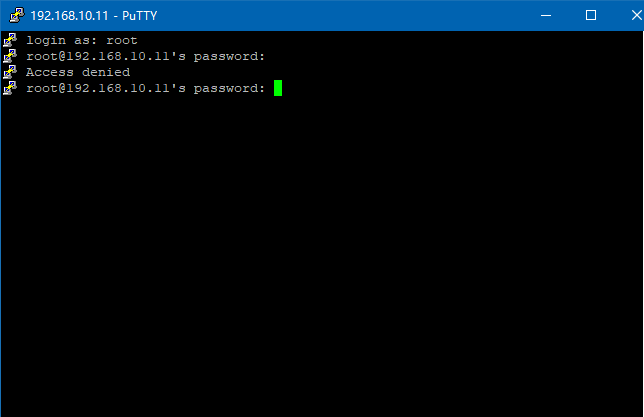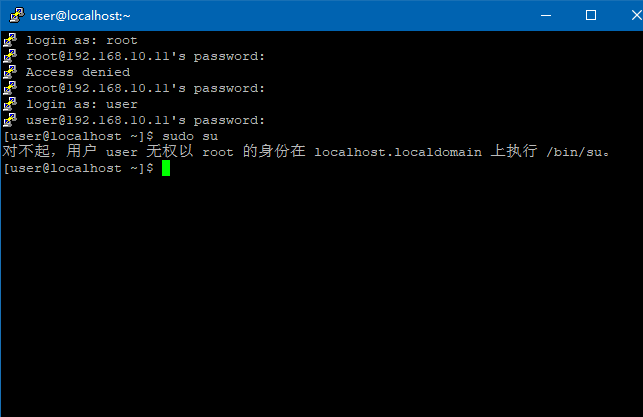一、系统服务配置
1.1.网卡配置修改
[root@localhost ~]# vim /etc/sysconfig/network-scripts/ifcfg-ens33
DEVICE=ens33
ONBOOT=yes
TYPE=Ethernet
NM_CONTROLLED=yes
BOOTPROTO=Static
IPADDR=192.168.10.11
NETMASK=255.255.255.0
GATEWAY=192.168.10.254
DNS1=202.106.0.20
DNS2=114.114.114.114
[root@localhost ~]# systemctl restart network
1.2.SElinux配置修改
[root@localhost ~]# vim /etc/sysconfig/selinux
#配置文件
SELINUX=enforcing 修改为 SELINUX=disabled
1.3.本地YUM源配置修改
[root@localhost ~]# mkdir /media/cdrom
[root@localhost ~]# mount /dev/sr0 /media/cdrom/
[root@localhost ~]# cd /etc/yum.repos.d/
[root@localhost ~]# vim /etc/yum.repos.d/CentOS-7.7.repo
#配置文件
[CentOS_Server]
name=CentOS repo
baseurl=file:///media/cdrom
enabled=1
gpgcheck=0
#gpgkey=file:///etc/pki/rpm-gpg/RPM-GPG-KEY-CentOS-7
1.1.1.设置开机自动挂载
[root@localhost ~]# vim /etc/fstab
#配置文件
/dev/cdrom /media/cdrom iso9660 defaults 0 0
[root@localhost ~]# yum clean all /*清理*/
[root@localhost ~]# yum list all /*加载*/
[root@localhost ~]# yum makecache /*缓存*/
二、系统安全配置
2.1.SSH配置修改
[root@localhost ~]# vim /etc/ssh/sshd_config
#配置文件(关闭root用户SSH登陆)
PermitRootLogin yes 修改为 PermitRootLogin no
[root@localhost ~]# systemctl restart sshd
2.2.Sudo权限修改
[root@localhost ~]# vim /etc/sudoers
[root@localhost ~]# visudo
#配置文件
## Allow root to run any commands anywhere
root ALL=(ALL) ALL
#添加下列一行
user ALL=NOPASSWD:ALL,!/usr/bin/passwd root,!/sbin/visudo,!/bin/bash,!/bin/sh,!/bin/tcsh,!/bin/su
#注释%wheel一行
## Allows people in group wheel to run all commands
#%wheel ALL=(ALL) ALL
2.3.Firewalld配置修改
2.3.1.常规操作
*关闭和禁用防火墙
[root@localhost ~]# systemctl stop firewalld
[root@localhost ~]# systemctl disable firewalld
*指定开放端口
#添加命令
firewall-cmd --zone=public --add-port=80/tcp --permanent
*注释:(--permanent永久生效,没有此参数重启后失效)
#重新载入命令
firewall-cmd -reload
#查看命令
firewall-cmd --zone= public --query-port=80/tcp
#删除命令
firewall-cmd --zone= public --remove-port=80/tcp --permanent
2.3.2.Firewalld的基本使用
启动服务: systemctl start firewalld
关闭服务: systemctl stop firewalld
查看状态: systemctl status firewalld
开机禁用 : systemctl disable firewalld
开机启用 : systemctl enable firewalld
2.3.3.Systemct是CentOS7的服务管理工具中主要的工具,它融合之前Service和Chkconfig的功能于一体。
启动一个服务:systemctl start firewalld.service
关闭一个服务:systemctl stop firewalld.service
重启一个服务:systemctl restart firewalld.service
显示一个服务的状态:systemctl status firewalld.service
在开机时启用一个服务:systemctl enable firewalld.service
在开机时禁用一个服务:systemctl disable firewalld.service
查看服务是否开机启动:systemctl is-enabled firewalld.service
查看已启动的服务列表:systemctl list-unit-files|grep enabled
查看启动失败的服务列表:systemctl --failed
2.3.4.Firewalld-cmd操作使用
查看版本: firewall-cmd –version
查看帮助: firewall-cmd –help
显示状态: firewall-cmd –state
查看所有打开的端口: firewall-cmd --zone=public --list-ports
更新防火墙规则: firewall-cmd –reload
查看区域信息: firewall-cmd --get-active-zones
查看指定接口所属区域: firewall-cmd --get-zone-of-interface=eth0
拒绝所有包:firewall-cmd --panic-on
取消拒绝状态: firewall-cmd --panic-off
查看是否拒绝: firewall-cmd --query-panic
三、重启系统检测
[root@localhost ~]# reboot
3.1.检测SSH登陆情况
#提示拒绝root用户访问链接,则正常

3.2.检测sudo权限情况
#提示user用户没有权限执行,则正常

3.3.检测本地yum挂在情况
#使用以下命令查看是否挂载,出现此路径,则正常
[user@localhost ~]$ sudo mount

3.4.检测防火墙是否启用情况
#使用以下命令进行查看,未运行,则正常
[user@localhost ~]$ sudo systemctl status firewalld.service

3.5.检测SElinux是否关闭情况
#使用以下命令进行查看,SELINUX是“disabled”,则正常
[user@localhost ~]$ sudo more /etc/sysconfig/selinux


